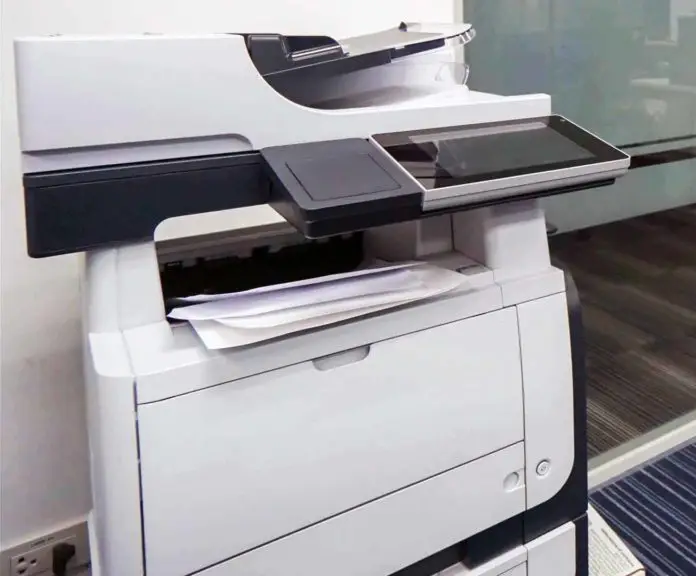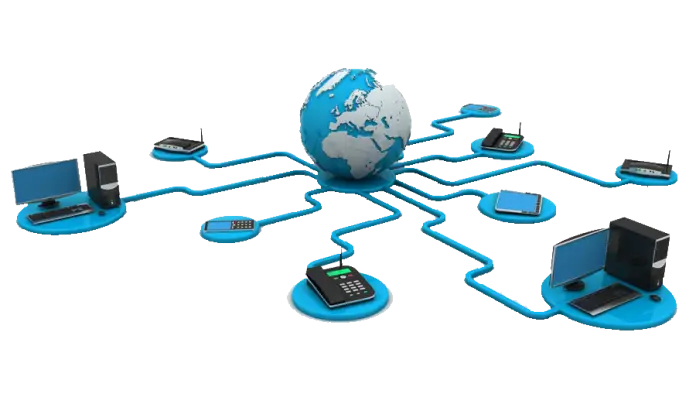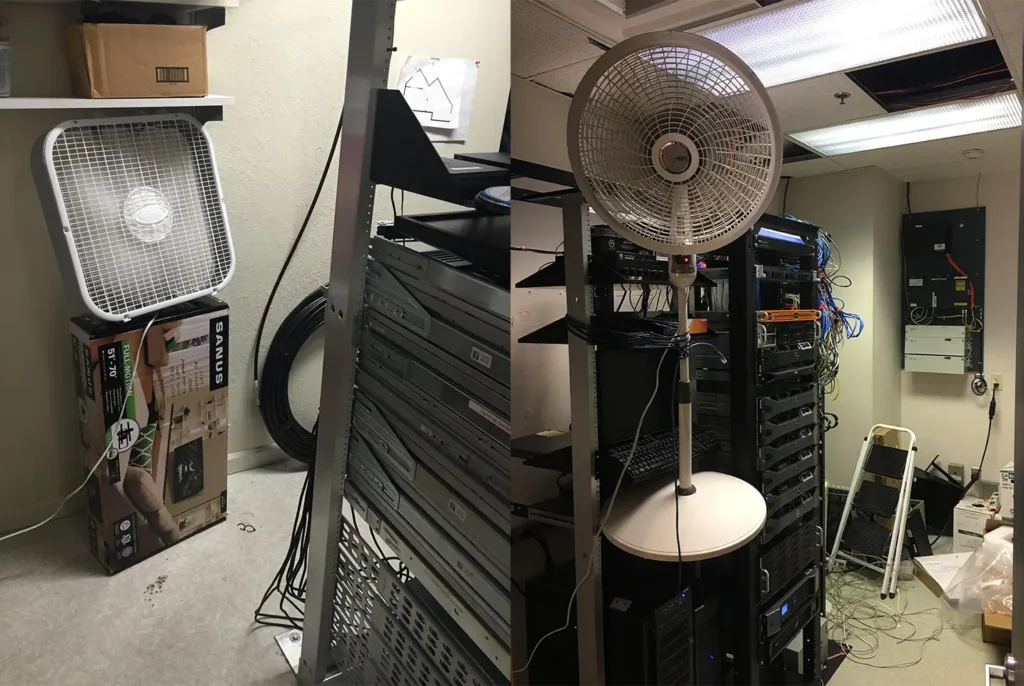Technology Moves
don't have to be hard
DC the Computer guy
To start with, Office Moves and Technology Moves aren’t the same.
Most small business owners and managers dread office moves, and who can blame them? There’s an abundance of things to worry about, from getting boxes to keeping people from popping the bubble wrap, and that’s before we get to the fun and stress of moving the office technology. Technology Moves add another level of complexity.
It’s not like a lamp that you unplug here and plugin there. Computers, networks, phones, and basically anything with an electronic pulse needs to be specially handled, and the place they’re going need to be properly prepared. It can be overwhelming to figure out how just to get started.

A moving experience
Over the years, CLARK has successfully moved the entire IT infrastructure for hundreds of small businesses. At first, it was just me moving everything – AND yes, I will admit it was nerve-wracking for me too! It took only a few of them for me to realize that planning is the key to a successful move. Once I understood that, the moves became easier, and it’s now one of our favorite jobs.
Moving an IT infrastructure can be pretty complicated. Not only do you have to worry about disconnecting and moving the technology, but you also have to figure out what services you need, when to order them, and how to reconnect everything in the new location. With so many things to budget for already, finding places to save money can be important, and IT companies typically charge exorbitant fees to move technology. Because of that, I’ve seen many attempted DIY office moves, and in my experience, it doesn’t save money. If anything, it ends up costing a whole lot more.
When things aren’t working after the move, the problems tend to lie in the new infrastructure, and that’s a time-consuming fix!
On the opposite end of the spectrum, I’ve seen small businesses do the right thing and call for help, but because their IT company was either inexperienced or not organized or both, the move turned into a mess.

CLARK has been called into action for both situations, and believe me, straightening out a mess is much more expensive than doing it right the first time!
some moving advice
After completing my first few moves, I discovered that if we pay attention to a few key aspects, the move itself could be a breeze. As CLARK has continued to grow, we have successfully completed enough technology moves with these best practices that I thought I would share.
First, your new office must be made ready for your technology. I shake my head whenever I see this aspect violated by an IT company. Whether you’re doing it yourself or if you have an IT company helping you, three things must be done to make sure that the new space is ready for the technology:
#1 Call Your Vendors
Contact your internet and phone provider, e.g., Comcast or Verizon, and schedule the service to be connected on the day of the move. If you have a static IP address for your Internet connection, make sure you let them know that you want it moved as well. For the phones, check every phone number and be sure to include fax lines as well as the phone number to your fire alarm.
Pro Tip
Call your providers (and vendors like IT) one week before the move to double-check the scheduled date and time. Assume that one of them will make a mistake on the calendar – better safe than sorry!

#2 Conduct Site Visits
Are there power and data outlets at desk locations? This gets missed A LOT, and then it’s a scramble to the store to buy extra long network cables and extension cords for power. Avoid these problems by ensuring that connections for both your phones and computers are EVERYWHERE you need them.
Anywhere you have a desk and computer, you will need power outlets and network drops for the computer and phone. With cabling services in-house at CLARK, I know what it takes to fix this after the move. Taking care of it ahead of time saves you a lot of time and money.
#3 Inventory everything that goes on the network
Identify everything that needs to be connected to the network and use a floorplan drawing to annotate the location of drops and WiFi locations. This way, you’ll know where things like a wireless access point, security cameras, and conference room equipment will be needed. I like to walk the existing office and list everything I see that needs to be connected to the network or Internet. Once I have this list, it’s just a matter of knowing where each item will be relocated and confirming that power and network connections are available. If there’s not, it will be much easier to have these installed before moving everything in.
Pro Tip
Have your IT company verify that the outlets work and are connected back to where you will have your servers, network equipment, Internet connection, and phone service.
manage your vendors
Be sure your vendors are coordinating with one another. This is critical but almost ALWAYS missed – and missing it causes confusion and a lot of bumbling around during the move. One of the things we do best at CLARK is coordination, and it has allowed us to excel at things like moving small businesses’ IT infrastructures. We take this headache away by doing the coordination ourselves, and here are the four primary steps we take:
Pro Tip
We ask movers to keep desks at least 6” away from walls for easy access when connecting power, voice, and data. You can kill time trying to plug cables in blindly!
#1 We coordinate with the moving company
Pro Tip
We ask movers to keep desks at least 6” away from walls for easy access when connecting power, voice, and data. You can kill time trying to plug cables in blindly!

#2 We contact your printer vendor
This is vital if you have a printer or copier under a lease!
Many leasing contracts state that if you move a leased printer yourself, it will void the warranty, which can be very costly. Beyond this, almost everyone forgets that these printers need a network connection in addition to power.
So many times, we’ve gotten calls about office printers not working, only to show up and find that they’ve been put into a corner with no network connections anywhere close.
#3 We coordinate access to the new location
There are few things more frustrating than showing up for part of the move process and finding the building locked. It might seem like common sense, but we’ve shown up to find the new location locked enough times to know just how important this step can be. This move is going to be costly enough without having to pay people to stand around and wait to work.
All during the move process, from the planning process up to the final move, people will need access to the new location. To make sure no one wastes time waiting on keys, we do the following:
- Create a log to record all keys. Knowing who has keys to your new location is essential to your security. With the log, we note which employees and vendors have keys or security codes, along with the time and date they were provided. Every key gets signed out with the understanding that the person signing for it is responsible for ensuring that it is not duplicated and gets returned at the end of the move.
- Ensure that everything is unlocked when people arrive. Vendors, contractors, and movers will charge you for any time spent standing around if they are waiting for someone to bring keys. Trust me, this little step gets missed too many times.
- Setup a calendar reminder to collect the keys post-move. All keys must be collected—forgetting is not an option! It’s always prudent to think about the physical security of your location, and you want to start off on the right foot in your new office.

#4 We coordinate the broadband and phone service
I know I mentioned this already, BUT it deserves mentioning again. In today’s world, you can’t do business without the Internet or your phones, so not having either available will cost you money, and that cost compounds for every day you have to wait to get one or the other installed. Not only do you need to make sure that both your phone and Internet providers know what to do, but it’s important to coordinate the time and day with your IT company or phone vendor, so they can be there to make sure that it’s done right.
don't forget the little things
Sometimes I figure things out quickly, and other times I choose a more difficult path. One of the things that I learned the hard way was that the small details matter the most when doing something complicated, and infrastructure moves can be just as complicated as building a network. Here are a few lessons learned that are worth the time to take:
#1 Label, Label, Label, Label
Did I mention Label?
Every phone, computer, monitor, and printer must be labeled with each employee’s full name and the location of the equipment in the new office. This ensures that no one’s equipment gets mixed up with anyone else’s. The last thing you want is for people to show up on their first day in the new office and spend time looking for the stuff they need to do their jobs. Avoid this confusion by ensuring everything is labeled.

#2 Purchase trash bags for the move
They are useful for more than just collecting trash!
At CLARK, when we do technology moves, we use plastic bags to gather the odds and ends that come along with a computer. For example, when we break down an employee’s computer, we’ll put the keyboard, mouse, power cable, adapters, etc., into a bag – that we will then label. This way, nothing gets misplaced, and we have everything we need to connect the computer back together at the other end.

Also, you will find that doing an office move generates a great deal of trash!
#3 Don’t forget lunch and water
Moving is hard work, and I’ve always found that supplying water and food (who doesn’t like free pizza or subs) shows your employees that you care and appreciate them.
On the business side, it also avoids the downtime that comes with people going out to find their own food and water. When it comes down to it, the benefits of providing food and water far outweigh the cost.
#4 Discuss the Server Room with IT
This one is extremely important! The room or closet that will house your network equipment must be ready for the servers and routers, which means having ample power, ventilation, cabling, and panels. If you’re thinking about doing this move yourself, please engage with your IT company for this part – fixing this after the fact will cost you a lot more time and money than you want to spend.
One of the biggest mistakes people make is putting the equipment in a room or closet that lacks the proper ventilation and power, tripping breakers, and causing equipment to overheat. Few things look as unprofessional or insecure as being forced to keep the door to the server room open to keep it from overheating. Having your IT company review the space to ensure it’s ready on day one is essential.

test everything
Finally, don’t let IT leave until everything – and I mean everything – is tested. It doesn’t take long, but for some reason, many IT people don’t test things, and this causes issues almost every time. No matter how thorough you are, something always gets missed. This is why testing is critical. The day after a stressful move, the last thing you want to do is show up to find that your employees can’t get their work done because they can’t open programs, get to the Internet, or access their email.
I take testing seriously and strongly believe in it, so at CLARK, we go to every desk and test every computer:
- Open a web page to confirm the internet is working.
- Perform a speed test on the internet
- Print test pages from every computer with a printer installed
- Verify shared cloud and/or network drives are connected
- Open the email program, i.e., Outlook, and send a test message
- Open shared resource programs to ensure they are working
- Turn on all conference room TVs
- Connect to Wireless Networks and test access and speed
- Make a test call from every phone
- Ask employees with remote access to log in from home
As I’ve grown Clark Computer Services, I found that planning brings success and that same principle applies to moving the IT infrastructure of your small business. In today’s busy world, it’s far too easy – and tempting – to skip steps to cut costs. But don’t fall victim to that trap when doing an office move. Contact us at 301-456-6931 or email [email protected], and we’ll take the stress out of the technology move for you.
Not only do we love moving small businesses’ technology, we’re good at it!

President And Owner
I left big business to start Clark Computer Services in 2003; not because I had a grand vision, but because I had three young children who needed their Dad around. Knowing I had to replace my salary, I went door-to-door visiting small businesses to introduce myself and ask if they needed IT support. I heard story after story from business owners and office managers about IT companies not returning calls and emails, grumpy technicians showing up late or not at all, and systems being down for days, weeks, and in some cases…months. I realized quickly that there was a clear and pressing need for reliable, honest, and professional IT support completed pleasantly and on time.

